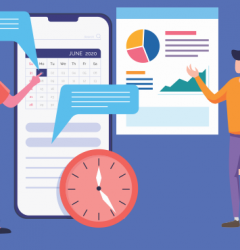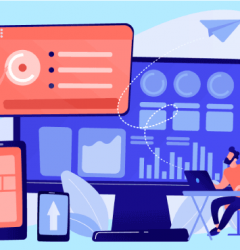
This article was first published on Customer Think
Here’s one of the many predictions for 2023: Digital transformation driven by the shift to hybrid and remote work will continue to accelerate.
COVID-19 served as a wake-up call for companies dragging their feet on digitization. Organizations of all sizes were forced to accelerate their adoption of digital platforms in order to remain operationally efficient.
As we transition from pandemic-triggered transformation to the next wave of digitization, some exciting developments are anticipated in two areas of technology that will enable operational agility: no-code platforms and hyperautomation.
The Rise of Hybrid Work will drive No-Code Adoption
Typically, hybrid work involves working from the comfort of home and working at the office. Because of the rise of hybrid work, “work” is no longer location-centric but experience-centric. This represents a fundamental shift in how organizations approach the workplace in the existing scenario.
As per Gartner, the reliance on remote development during the pandemic will continue to expedite no-code/low-code adoption.
Creating an engaging experience in people’s work processes is critical for efficiency, retention, and employee satisfaction. No-code development will be essential in this experience-driven era of work. Employees’ natural desire for low-friction experiences will encourage more of them to create and use no-code apps that will simplify and streamline their work lives.
It will free up highly skilled engineers and focus on innovation programs with greater strategic significance. This will create a pool of IT specialists who can take up high-value projects instead of building basic workflow applications. Using no-code platforms, employees can be creative with technology and develop their own custom applications. This can help CEOs in establishing a workforce that can think on its feet and deliver independently, and as a result, sparking a culture of innovation across the organization.
Also read: Top Benefits of No-Code App Development
Organizations will increase investments in formal citizen development programs
Unsurprisingly, no-code automation has become an essential part of the CIO agenda. No-code platforms put process innovation tools in the hands of those who are closest to the problems – the business users. As a result, productivity has increased, and digital transformation accelerated.
In 2023, the use of these tools will increase and become more structured. As more businesses recognize the value of no-code development, they will establish formalized citizen developer programs that provide their employees with tools to experiment and deliver value. Citizen development requires coverage on strategic, tactical, and operational levels in order to support enterprise innovation. It is essential to create fusion teams and clearly demarcate the roles and responsibilities of not just citizen developers but also technical people.
To oversee whether the strategic goals are being met, there should be a citizen development champion in the team who can influence or give directions to both citizen developers and IT teams. Someone from the top leadership (CEO or CIO) is suitable for this role. He or she can also work as an icebreaker between business users and IT personnel if the situation demands it.
Simultaneously, we’ll see IT leaders implement no-code development safeguards, such as platform-level security and access controls. As a result, no-code apps will combine enterprise-level scalability with enterprise-level security and compliance.

Hyperautomation will make further inroads into the mainstream
While many organizations are still testing the waters with process automation, visionary companies are getting well-versed in the new reality called “hyperautomation.”
Hyperautomation is not a standalone initiative or tool and is the result of an organization’s approach to automation. Hyperautomation combines a wide range of technologies such as machine learning, artificial intelligence, robotic process automation, no-code capabilities, and others.
Hence, there is an ongoing effort to identify, automate, and optimize business processes throughout the enterprise. The leadership will have enough gumption to automate legacy applications building an agile workforce that can work its way through evolving technologies, operations, and business requirements.
According to Gartner, the need for business-driven hyperautomation will be one of the top three drivers for low-code adoption through 2023.
To build a deck of automation solutions and achieve enterprise-wide automation at a rapid pace in an agile, responsive, and time-efficient manner, many organizations are experimenting with cutting-edge technologies and tools that non-technical workforce from different domains can leverage.
Considering the fact that cross-enterprise processes are the backbone of digital enterprises, automated systems that can constantly optimize the way people, processes, and technology interact have enormous power. Over the coming year, more enterprises will implement AI at scale into their processes, resulting in more intelligent decision-making, recommendations, and optimization.
Also read: Hyperautomation – What, Why, and How?
No-Code Automation in 2023
As organizations around the world shift to a hybrid workforce model, it’s becoming increasingly clear that non-technical employees should be pushed toward citizen development rather than overload remote-based IT teams with day-to-day troubleshooting. The goal is to democratize and accelerate innovation by allowing business analysts, product designers, and marketers to build their own applications without writing a single line of code. This ongoing effort to cultivate code-agnostic development teams is one of the most significant trends, and it is gaining traction with the success of no-code platforms such as Quixy.
The future of coding is no-code coding, and the future of automation is no-code automation. Organizations strive for end-to-end automation while advocating for a hybrid workforce model (reduced availability of IT resources for everyday tasks). No-code platforms like Quixy are evolving and providing an excellent opportunity for business and IT leaders to achieve their primary strategic goals, the most important of which is enterprise-wide automation.
Login
Please login to comment
0 Comments
Oldest















